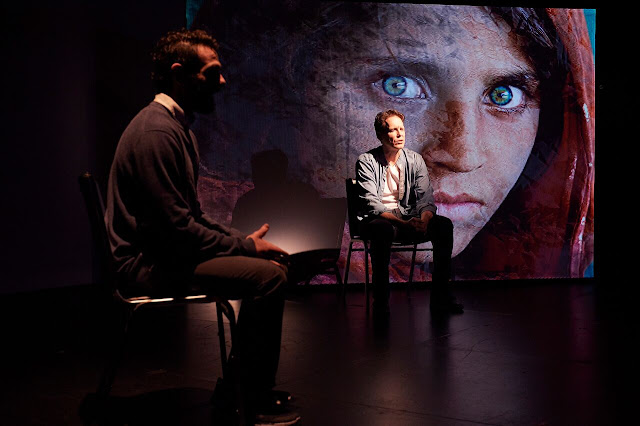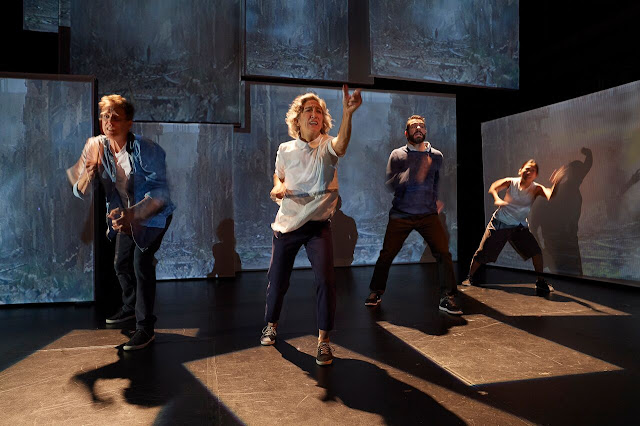trace
A Factory production in association with b current performing arts
trace follows three generations of mother and son from the Japanese occupation of Hong Kong to Canada in the 21st century. Combining virtuosic original piano compositions with an incredible performance and lyrical text, this exquisite and stimulating one man chamber play offers a new look into the lasting implications of sacrifice across generations.
JEEF HO (WRITER/PERFORMER)
NINA LEE AQUINO
(DIRECTOR)
INTERVIEW
could you talk about how the story/play began in your mind as a playwright, and how the concept became a reality with the support of a director/dramaturge
JEFF: The core story of trace stemmed from various myths and memories from family - a collection of mysteries that my mother shared with me when I was a child. One particular memory, of my Great Grandma's exile from China to Hong Kong during WWII stuck with me. She had two sons, and during her journey, something happened to her youngest son and he disappeared. My Great Grandma was a resilient, powerful woman and shame is a very thorny subject in our culture, so she simply dismissed any conversations around her missing son. My mother took a similar journey (though not during war times) when she uprooted her life in Hong Kong and immigrated to Canada with my brother and me, so I became fascinated with these parallels within our family, and wrote this play as an attempt to trace the stories of survival, sacrifice, and strength in my bloodline.
Initially, I wrote this piece as part of a 2nd year project at the National Theatre School: it was a long form piece of poetry, dealing with the imagined scenario of what could have happened to this missing son. I shared it with Nina while she was teaching there, and we began our working relationship on the piece from then on. Under the guidance of Iris Turcott, Matt McGeachy, and Nina, I began to expand upon these initial myths to three generations of women (Great Grandma, Grandma, and Ma), and we begun to piece together these memories (both imagined and true) to what it is today, with classical piano becoming a huge part of the structure and motion of the piece.
how did the director approach this script in order to make it a staged reality
NINA: - Always with love. Always from an authentic, therefore vulnerable, place.
- I like looking at plays from the outside-in, that’s how I access the work. If I understand the container of the words (text), then my understanding of how the characters and why they operate the way they do in the world of the play opens up immensely.
- From there, then my designers and I can build the theatrical world of the play and my rehearsals become discovering that world, inhabiting it (and all its laws), mining it deeply.
how did the playwright approach the construction/representation of the female characters, i.e. what nuances speech patterns etc. were you able to tap into in order to bring these characters to life - and how might this have been a consideration for the playwright and director during the dramaturgy and/or directing process
JEFF: In doing research for the writing period of the piece, I interviewed my mother quite a bit, and recorded her storytelling. Because my partner (who's anglophone) would come to these interviews with me, my mother always felt compelled to articulate these memories in English (her third language). I noticed the rhythms, succintness, and grammar of her stories, and noticed how factual the memories became. It was hard for her to articulate the depth of emotion in many of the harsher tales, simply because of the limits of a learned language - for example, in one interview, she said: "Your uncle. he was just a boy. he swam and swam and swam across the ocean. then, he was safe." This was fascinating to me, as one can imagine all the horrors, and terror, and all that involved in the story, but the simple facts of the narrative was what she could articulate... and that was enough. This lack of sentiment is something I've attempted to capture, this surgical precision to speaking deep pains in the simplest way possible.
NINA: - Again, we approached everything with love, authenticity but with great theatricality.
- Even though this is lifted and inspired from Jeff’s history, I didn’t want it to be just an autobiography on stage. I did not want it to be a documentary on stage. We needed to find theatrical elements and magic that represented his emotional journey -- that to me is more interesting; more powerful.
- It was important for me to allow Jeff to express his fullest self in this piece, embracing all the facets of the man he has become because of all these women.
what was the inspiration for the idea of the pianos as representation of the male characters
JEFF: Initially, and pretty early on, we landed upon the piano acting as various periphery characters in the play, men and women alike. However, for claritys sake (since what the piano speaks is never literal, and can never be as clearly articulated as language), we came upon the idea that all the pianos represented the men. I also felt jazzed about this idea, because the men in my family have often been the homewreckers/the troubled ones, and the women were the survivors that simply brushed away their nonsense, to live their lives to the fullest, with or without these men.
what is the underlying theme/message of the piece
JEFF: For me, the core theme for this piece deals with the reckoning that life is only possible because of the joys, woes, and sacrifices of our ancestors. This feels obvious as I type it, but laying out each thread of my familial past has given me a deeper gratitude and perspective on what it means to live... to survive.
trace runs at Factory Theatre
November 16th until December 3rd
 My bias within this variety of iconic performance would be the drag role. A CHRISTMAS CAROL not only rises to the occasion, it makes the ‘drag queen’ into a star turn that holds the overall narrative together and paves the way for a virtuoso performance by Dan Chameroy as the beloved Plumbum.
My bias within this variety of iconic performance would be the drag role. A CHRISTMAS CAROL not only rises to the occasion, it makes the ‘drag queen’ into a star turn that holds the overall narrative together and paves the way for a virtuoso performance by Dan Chameroy as the beloved Plumbum. 


































